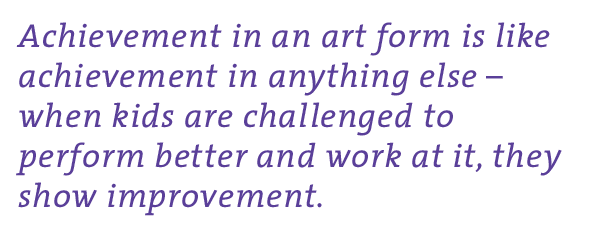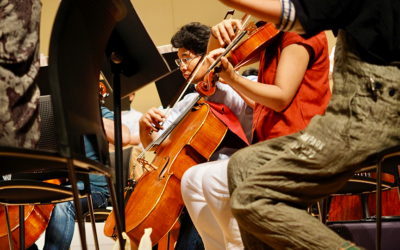Imagine a world where every weekend parents and grandparents spend hours cheering on a child’s efforts in dance, music, theatre or the visual arts. Imagine a world where a family’s excitement over a child’s A in an arts class mirrors that of an A in math or their child scoring the winning goal in soccer. Imagine a world where families encourage their children to work as hard in the arts as they do in other subjects or sports.
Hard to imagine? Why?
Most individuals readily accept data showing a host of benefits to children who study dance music, theatre and/or the visual arts. The problem is they don’t think it applies to their child. Unless their child is exceptionally talented, they don’t think spending time in the arts is as worthwhile as other endeavors.
Too often, this leads to parents indulging their child’s interest in the arts to a small extent, but never with the purposefulness it deserves and with nowhere near the level of engagement they demonstrate when a child works hard in other subjects or plays a sport.
But achievement in an art form is like achievement in anything else – when kids are challenged to perform better and work at it, they show improvement. Most children are not gifted at math but are taught early on that they must at least become proficient in it. It should be the same with the arts.
Estimates are that only 1 in 10,000 individuals have perfect pitch – the ability to identify or sing a musical note without the aid of any reference tone. It has long been believed you’re either born with this ability or you’re not.

This is typical of how people feel about the arts in general. Either the arts come naturally, or one shouldn’t waste their time. This myth of natural talent leads to children (and adults) thinking they can’t draw or play an instrument unless it comes easily. This is the very antithesis of the growth mindset needed to succeed in life. Never would we take that approach to science, math or reading. Of course, it takes hard work.
In 2014, Ayako Sakakibara released results of a longitudinal study showing she was able to teach children to identify notes by pitch. Some children picked it up more quickly than others, but every single child was eventually able to develop this ability, even if it took years.
That is not to say talent or a predisposition to excel at something doesn’t exist. It does. And it explains why some students were able to develop perfect pitch more quickly than others. But disposition is not destiny.

Children who are not prodigies in the arts can still learn and grow. Many of those without natural talent will still, over time, achieve remarkable things.
Parents discount the arts because they care about their children and are afraid they are wasting their time, but that’s not the case. All the data shows that. Not only does studying the arts benefit a student during the K-12 education, but these benefits continue leading to both higher rates of college enrollment and graduation. And yes, even scholarships are available for merit in an art form.
Hardly any students who play youth sports will receive college scholarships. Of those that do, many will give up their scholarship after one or two years. Of those that continue, only a very small fraction will go on to play professional sports.

Does this mean youth sports are a waste of time? Absolutely not. But it does provide a point of comparison.
We have a robust pipeline in this country to develop athletes, even though it is not a path to a career. We need a pipeline to develop creative thinkers and problem solvers. Studying the arts does this and can lead to a multitude of careers.
When we fail to encourage the development of the skills required to produce in each art form, we leave unrecognized potential on the table that can be used in many fields. There are real consequences to not recognizing the gravity of arts learning.
The arts matter – they provide the most essential of skills, like creative thinking, perseverance and self-discipline, that benefit all people in all areas of their lives.
We all want our children to succeed to make their mark on the world. So, let’s get serious about encouraging them to do just that.
The Northeast Florida Art Educators Association hosted the 7th annual Northeast Florida Scholastic Art Awards on Saturday, February 3, 2018. CAP was honored to host the Gold and Silver Key portfolio winners in the Heather Moore Community Gallery.
The exhibition featured the work of 44 Gold Key and 34 Silver Key portfolio winners that were selected from more than 2,868 submissions by students in Clay, Duval, Nassau, St. Johns and Volusia counties.
These students were recognized for their accomplishments in the visual arts, and many received scholarships to partnering institutions like Savannah College of Art and Design, Jacksonville University, University of North Florida and New Hampshire Institute of Art. In 2017, the Northeast Florida Scholastic Art Awards was able to offer $5.1 million in scholarships to regional individual and portfolio winners. In addition, the works of Gold Key winners progressed to national adjudication where some earned a place at the ceremony at Carnegie Hall where national medals, scholarships and inclusion in a national traveling exhibition were awarded.
Editors note: This post has been updated for accuracy as of December 2023.



